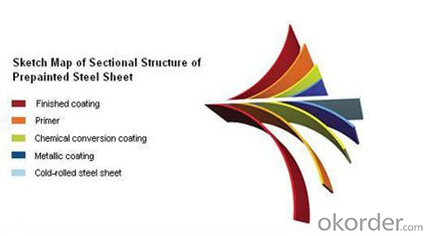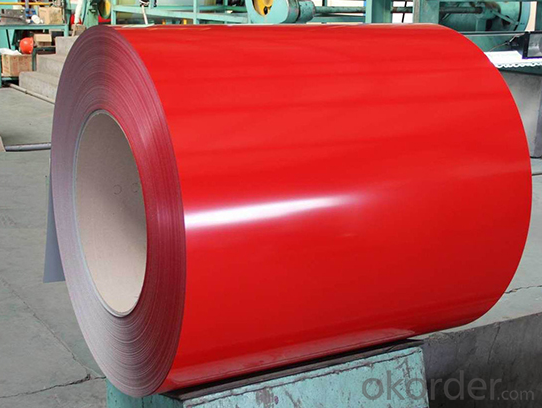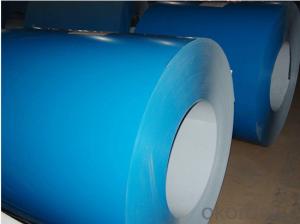Color Coated Pre-Painted Steel Coil in High Quality in Blue
- Loading Port:
- Shanghai
- Payment Terms:
- TT OR LC
- Min Order Qty:
- 50 m.t.
- Supply Capability:
- 100 m.t./month
OKorder Service Pledge
OKorder Financial Service
You Might Also Like
1:Pre-Painted Galvanized/Aluzinc Steel Coil Description:
Pre-painted Galvanized/Aluzinc Steel Coil with GI or Aluzinc as base metal,after pretreatment,degrease , chemical treatment and liquid dope with several layers of color ,then after fring and cooling ,finally become pre-painted galvanized/aluzinc steel with good capable of decoration,molding,corrosion resistance,superior workability,durability and weather resistance.
2:Quick Details of the Pre-Painted Galvanized/Aluzinc Steel Coil
Standard | ASTM ,EN,JIS | Grade: | CS,DX51D+Z,CGCC | Thickness | 0.16mm-1.5mm |
Place of Origin | China(Mainland) | Brand Name | Type | Steel Coil | |
Technique | Galvanized/Aluzinc | Surface | Coated | Application | Roof panel |
Width | 900mm-1250mm | Length | Coils | Zinc Coating | 30g/m2-275g/m2 |
Paint | Standard PE,PVDF,PU | Color | RAL Scale | Coil Weight | 3mt-7mt |
3:Packaging & Delivery
Packing: Export Standard Packing (full wrapped with anti-damped paper inside, iron sheet wrapped outside, and bundled by iron strips)
Delivery:30-45 Days
Detail Images:


Size can be customized
Financial support with max 180 days unsance L/C
Prime quanlity, competitive price
Fast delivery time.
4:PPGI / GI Steel Sheet
1) AVAILABLE DESIGNATION OF PPGI/PPGL Prepainted Galvanized/Aluzinc Steel Coils
Quality | Q/BQB 440-2003 | JIS G3312-1994 | EN 10326-2004 | ASTM A653-02a |
EN 10327-2004 | (BASE PLATE) | |||
(BASE PLATE) | ||||
Commercial Steel | TDC51D | CGCC | DX51D+Z/AZ | CS Type A/B/C |
Forming Steel | (TSt01,TSt02,TSt03) | CGCD1 | FS Type A, Type B | |
Drawing | TDC52D /TDC53D | - | DX52D+Z/AZ | DDS TYPE A/C |
Steel | DX53D+Z/AZ | |||
Structural | TS280GD(TStE28) | CGC400 | S280D+Z/AZ | SS275 |
Steel | TS350GD(TStE34) | CGC440 | S350D+Z/AZ | SS340 Class1 |
2) OUR SPECIFICATION OFPPGI/PPGL (Prepainted Galvanized/Aluzinc Steel Coils)
Thickness | Width | Length of plate | Inner diameter of coil | |
0.16-1.2mm | 800/914/1000/1200/1219/1250mm | 1000-6000mm | 508mm/610mm |
Coated Mass OF PPGI/PPGL (Prepainted Galvanized/GalvalumeSteel Coils) :
Base plate | Available Coated Mass(g/m^2) |
Galvanized Steel | 80, 100, 120, 160, 180, 200, 275 |
Galvalume Steel | 50, 70, 150 ect. |
Available Painting OF PPGI/PPGL (Prepainted Galvanized/GalvalumeSteel Coils) :
Category of Painting | Item | Code | |
Polyester | PE | ||
High-durability polyester | HDP | ||
Silicon modified polyesters | SMP | ||
Polyvinylidene fluoride | PVDF | ||
Easy-Cleaning | — | ||
Painting Thickness | Top side: 20+5microns; | ||
Bottom side: 5~7microns. | |||
Color System | Produce according to RAL Color System or as per buyer’s color sample. | ||
Painting structure | Top surface | Bottom surface | |
Primer coating | No coating | 1/0 | |
Primer coating | Primer coating | 1/1 | |
Primer coating + Finish coating | No coating | 2/0 | |
Primer coating + Finish coating | Primer coating or single back coating | 2/1 | |
Primer coating + Finish coating | Primer coating + Finish back coating | 2/2 | |
Note: Protect film available
3) APPLICATION OF PPGI/PPGL (Prepainted Galvanized/GalvalumeSteel Coils)
Construction | Outside | Workshop, agricultural warehouse, residential precast unit, corrugated roof, roller shutter door, rainwater drainage pipe, retailer booth |
Inside | Door, doorcase, light steel roof structure, folding screen, elevator, stairway, vent gutter | |
Electrical appliance | Refrigerator, washer, switch cabinet, instrument cabinet, air conditioning, micro-wave oven, bread maker | |
Furniture | Central heating slice, lampshade, chifforobe, desk, bed, locker, bookshelf | |
Carrying trade | Exterior decoration of auto and train, clapboard, container, isolation lairage, isolation board | |
Others | Writing panel, garbage can, billboard, timekeeper, typewriter, instrument panel, weight sensor, photographic equipment | |
- Q:How are steel coils loaded onto a truck?
- Steel coils are typically loaded onto a truck using a combination of machinery and manual labor. The process involves several steps to ensure the safe and efficient loading of the coils. Firstly, the truck must be properly prepared for the loading process. This includes ensuring that the truck's bed is clean and free from any debris or obstacles that may interfere with the loading. The truck's bed may also be lined with protective materials such as rubber mats to prevent damage to both the coils and the truck. Next, a forklift or crane is used to lift and position the steel coils onto the truck. The forklift or crane operator must carefully maneuver the coils into place, ensuring that they are balanced and secured to prevent any shifting during transportation. It is essential to follow proper lifting techniques and safety protocols to avoid accidents or damage to the coils. Once the coils are positioned on the truck, they may be secured using various methods. This can include using straps, chains, or other restraints to hold the coils in place and prevent them from moving or falling during transit. The restraints must be properly tightened and checked to ensure they can withstand the weight and movement of the coils. It is important to note that the specific loading process may vary depending on the size and weight of the steel coils, as well as the equipment available. Some trucks may have specialized loading systems designed specifically for steel coils, which can streamline the loading process and enhance safety. Overall, loading steel coils onto a truck requires careful planning, skilled operators, and appropriate equipment. Following proper procedures and safety measures is crucial to ensure the successful transportation of the coils and to prevent any accidents or damage.
- Q:i want a good modern carbon steel (not stainless) knife. trying to keep it under 50$ also nothing to gruesome just a small pocket knife. thank you
- Well, okorder /... They did make other folders in M2 steel, but the thing is those are out of production and the cost is very high. Spyderco made M4 steel folder knives, and so did Benchmade. Although,both are outside of 50$ budget. I guess Opinels are best option.
- Q:How are steel coils used in the manufacturing of oil and gas equipment?
- Steel coils are commonly used in the manufacturing of oil and gas equipment due to their durability and strength. They are typically formed into various shapes and sizes to create components such as pipes, tanks, valves, and fittings. These coils are processed and fabricated into these equipment to withstand the demanding conditions of the oil and gas industry, including high pressures, corrosive environments, and extreme temperatures.
- Q:Are steel coils corrosion-resistant?
- Yes, steel coils can be made corrosion-resistant through various methods such as galvanization or coating them with protective layers.
- Q:What are the different methods of coil joining for steel coils?
- There are several different methods of coil joining for steel coils, each with its own advantages and limitations. Some of the commonly used methods include: 1. Welding: This is one of the most popular methods of coil joining. It involves using heat to melt and fuse the edges of the steel coils together. Welding can be done using various techniques such as arc welding, resistance welding, or laser welding. It provides a strong and durable joint, but it can be time-consuming and may require skilled operators. 2. Mechanical fastening: This method involves using mechanical fasteners like clips, staples, or bolts to join the edges of the steel coils. Mechanical fastening is relatively quick and easy, and it allows for easy disassembly if required. However, it may not provide as strong a joint as welding and can be susceptible to loosening over time. 3. Adhesive bonding: Adhesive bonding involves using a suitable adhesive or glue to bond the edges of the steel coils together. This method provides a strong and uniform joint, and it can also help to seal and protect the joint from corrosion. However, adhesive bonding may require surface preparation and curing time, and it may not be suitable for high-temperature applications. 4. Interlocking or tongue-and-groove joints: This method involves shaping the edges of the steel coils in a way that they interlock or fit together like a puzzle piece. Interlocking joints provide good alignment and can be easily assembled and disassembled. However, they may not provide as strong a joint as welding or mechanical fastening. 5. Coil-overlapping: In this method, the edges of the steel coils are overlapped and clamped together using mechanical means. Coil-overlapping is a simple and cost-effective method, but it may not provide a strong joint and can result in uneven coil edges. It's important to consider factors such as the application requirements, strength requirements, cost, and production efficiency when choosing the appropriate method of coil joining for steel coils.
- Q:not iron, steel
- steel was first used in the 1800s in buildings.
- Q:How do steel coils contribute to the packaging industry?
- Steel coils play a crucial role in the packaging industry by providing a durable and versatile material for packaging various products. The use of steel coils in packaging ensures the protection and preservation of goods during transportation and storage. One way steel coils contribute to the packaging industry is through their strength and durability. Steel is known for its high strength-to-weight ratio, making it an ideal material for packaging heavy and bulky items. Steel coils can withstand significant pressure and impact, ensuring that goods remain intact and undamaged throughout the supply chain. This strength also allows for the stacking of packages, optimizing storage space and reducing the risk of damage. Furthermore, steel coils are highly resistant to corrosion and moisture. This property is particularly important in the packaging industry as it helps protect goods from environmental factors that could potentially compromise their quality. Steel coils can be coated or treated to enhance their corrosion resistance, ensuring that packaged products remain in pristine condition. Steel coils are also versatile and can be easily customized to suit specific packaging requirements. They can be cut and shaped into various forms, such as sheets, straps, or bands, to secure and protect different types of products. Additionally, steel coils can be easily integrated with other packaging materials, such as cardboard or plastic, to provide added strength and stability. Another benefit of steel coils in the packaging industry is their recyclability. Steel is one of the most recycled materials globally, and steel coils can be easily recycled and reused. This sustainability aspect makes steel coils an environmentally friendly choice for packaging, contributing to the reduction of waste and the conservation of resources. In summary, steel coils play a vital role in the packaging industry by offering strength, durability, corrosion resistance, versatility, and recyclability. Their use ensures the safe transport and storage of goods, providing a reliable and sustainable packaging solution for a wide range of industries.
- Q:How is steel different than iron?How many different kinds of steel are there?What type is the strongest?Which type is the weakest?
- As first answer says, if you look at the number of commercial steel alloys available and consider that any given alloy can be heat treated to a wide range of physical properties, there are thousands and thousands of potential combinations. Technically, steel is an alloy of Fe and C but there are Fe-C alloys that are called cast irons, not steel, and... there are lots of alloy steels which have significant amounts of other elements added like Cr, Ni, Nb, V, Mo, etc. Fe alloys that have a lot of Cr and or Ni added are called stainless steels and there are dozens of them and many of them can be heat treated to produce a wide range of properties. As far as the strongest or the weakest, you have to get really specific about exactly what you mean because some steels are designed for room temperature properties, some are designed for elevated temperature properties, some for static loads, some for impact loads, some for wear resistance, etc, etc.. Steels make up the largest family of metal alloys (by weight and by volume) that humans use. There are a number of reasons for this but the big reasons include: 1) there is a LOT of iron on earth 2) it is relatively cheap to produce 3) you can easily change the physical properties over a every wide range. As an example... you can take a piece of steel that is so brittle it will shatter if you drop it on the floor and heat treat it so you can bend it like a pretzel without cracking and then heat treat it again to make it very strong and tough (resistant to fracture).
- Q:Why do we galvanise steel? Galvanised steel is steel coated with zinc.
- it prevents the steel from rusting. Zinc rusts too, but more slowly than steel, and it doesn't tend to eat away it's structure. Zinc coatings prevent oxidation of the protected metal by forming a barrier, and by acting as a sacrificial anode if this barrier is damaged. Zinc oxide is a fine white dust that (in contrast to iron oxide) does not cause a breakdown of the substrate's surface integrity as it is formed. Indeed the zinc oxide, if undisturbed, can act as a barrier to further oxidation, in a way similar to the protection afforded to aluminium and stainless steels by their oxide layers.
- Q:What are the common coil diameter and weight combinations available for steel coils?
- The common coil diameter and weight combinations available for steel coils vary depending on the specific requirements and industry standards. However, there are some commonly used combinations that are widely available in the market. In terms of coil diameter, the most common sizes range from 24 inches (610 mm) to 72 inches (1829 mm). These diameters are typically used for various applications in industries such as automotive, construction, and manufacturing. Regarding coil weight, the range can vary significantly depending on the type and thickness of the steel being coiled. For hot-rolled coils, the weight typically ranges from 5 to 30 metric tons. Cold-rolled coils usually have weights between 2 to 20 metric tons. Coils with larger weights are commonly used for heavy-duty applications, while lighter coils are preferred for more delicate or precise applications. It is important to note that these are just general guidelines, and the actual coil diameter and weight combinations can be customized based on the specific needs of the customer. Different manufacturers and suppliers may offer a wide range of options to accommodate various industry requirements. Therefore, it's always advisable to consult with the specific supplier to determine the available coil diameter and weight combinations that best suit your specific application.
1. Manufacturer Overview |
|
|---|---|
| Location | |
| Year Established | |
| Annual Output Value | |
| Main Markets | |
| Company Certifications | |
2. Manufacturer Certificates |
|
|---|---|
| a) Certification Name | |
| Range | |
| Reference | |
| Validity Period | |
3. Manufacturer Capability |
|
|---|---|
| a)Trade Capacity | |
| Nearest Port | |
| Export Percentage | |
| No.of Employees in Trade Department | |
| Language Spoken: | |
| b)Factory Information | |
| Factory Size: | |
| No. of Production Lines | |
| Contract Manufacturing | |
| Product Price Range | |
Send your message to us
Color Coated Pre-Painted Steel Coil in High Quality in Blue
- Loading Port:
- Shanghai
- Payment Terms:
- TT OR LC
- Min Order Qty:
- 50 m.t.
- Supply Capability:
- 100 m.t./month
OKorder Service Pledge
OKorder Financial Service
Similar products
New products
Hot products
Related keywords






























